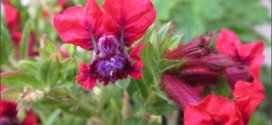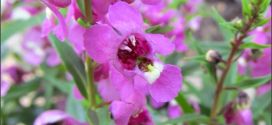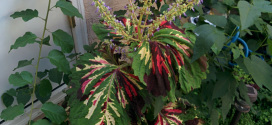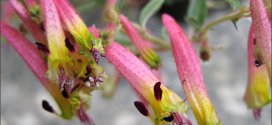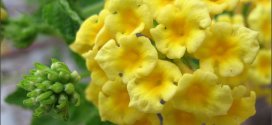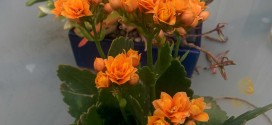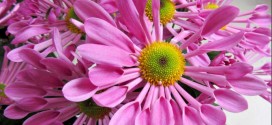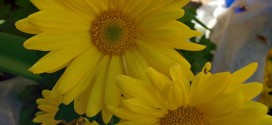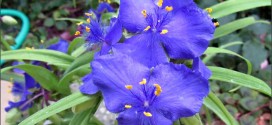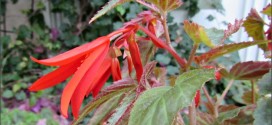Many gardeners have learned the value of Cuphea for summer long flowers. We value them not only for the small, attractive flowers, but also for the hummingbirds, butterflies, and nectar-feeding insects that swarm around them. Aka Bat-Face Cuphea, St. Peter’s Plant, Tiny Mice, Bunny Ears, Cuphea llavea. Cuphea is a family of plants containing about 115 species according to the …
Read More »Tag Archives: Filler
Angelonia
Native to Mexico and the West Indies, angelonia (sometimes also called summer snapdragon) is an upright, glabrous, somewhat bushy, tropical perennial that is noted for its long summer bloom of small snapdragon-like flowers. Plants typically grow 12-18” tall. Stems are clad with narrow, oblong to lanceolate, green leaves (to 3” long) with toothed margins. Foliage is slightly aromatic. Bluish-purple flowers …
Read More »Coleus
Coleus is a pretty foliage plant , Solenostemon scutellarioides Family: Lamiaceae (lay-mee-AY-see-ee) (Info) Genus: Solenostemon (sol-en-oh-STEM-on) (Info) Species: scutellarioides (skew-tell-ar-ee-OH-ih-deez) (Info) Synonym:Coleus blumei Synonym:Coleus scutellarioides Category: Annuals Tropicals and Tender Perennials Height: 12-18 in. (30-45 cm) 18-24 in. (45-60 cm) Spacing: 9-12 in. (22-30 cm) Hardiness: USDA Zone 9a: to -6.6 °C (20 °F) …
Read More »Cuphea cynea
Black eyed Cuphea, Tri-coloured Cuphea, Cuphea cyanea. Cuphea is attractive to bees and hummingbirds. Family: Lythraceae (ly-THRAY-see-ee) (Info) Genus: Cuphea (KYOO-fee-uh) (Info) Species: cyanea (sy-AN-ee-uh) (Info) Category: Shrubs, Tropicals and Tender Perennials Height: 24-36 in. (60-90 cm) Spacing: 36-48 in. (90-120 cm) Hardiness: USDA Zone 9a: to -6.6 °C (20 °F) USDA Zone 9b: to …
Read More »Lantana
Lantana is a great landscape plant. It attracts bees, butterflies, and hummingbirds. It is very drought-tolerant once established. Every winter I cut it back to its stumps; every autumn the plant has grown 12 feet wide. Obviously, you can prune it smaller.
Read More »Kalanchoe blossfeldiana
Kalanchoe blossfeldiana is native to Madagascar. It produces small mounds of orange flowers with scalloped shiny green leaves. It thrives with bright light and porous soil. Water thoroughly when soil is dry. Protect from frost. Kalanchoe’s only known enemy is lemurs so I think it safe.
Read More »Pink Spoon Mums
When fall arrives, it’s hard not to regret the passing of all the summer blooms we love so much: pompon dahlias, Shasta daisies, African daisies, little zinnias, asters, coreopsis, and calendulas. But take heart, for the fall garden offers all these flower shapes from just one plant, the chrysanthemum. Hundreds of hardy cultivars provide an array of colors and bloom …
Read More »Disk and Rays
Calendula is a well-known medicinal herb and uplifting ornamental garden plant that has been used therapeutically, ceremonially, and as a dye and food plant for centuries. Most commonly known as for its topical use as a tea or infused oil for wounds and skin trauma, the bright orange or yellow flower contains many important constituents and can be taken internally …
Read More »Tradescantia x andersoniana ‘Sweet Kate’
‘Sweet Kate’ is a compact, clump-forming, hybrid spiderwort that is noted for its unique yellow foliage. It typically grows to 12” tall. Three-petaled, purplish-blue flowers (to 1.5” diameter) accented by contrasting yellow stamens are borne in terminal clusters (umbels) atop stiff stems. Numerous flower buds form in each cluster, but individual flowers open up only a few at a time, …
Read More »Begonia boliviens s. ‘Santa Cruz Sunset’
The Santa Cruz Sunset begonia has dramatic angled petals. These plants fall into the tropical and subtropical category of perennials, growing well in U.S. Department of Agriculture plant hardiness zones 6 through 11. Many varieties with ornamental leaves and blossoms grow well outside in USDA zones 10 and 11, while hardy begonias survive winters in USDA zones 6 through 9 …
Read More »